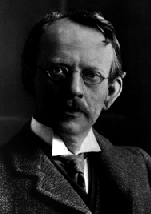|
(Files in red–history)
|
Experiments with beams of negative particles were performed in Britain by Joseph John ("J.J.") Thomson, and led to his conclusion in 1897 that they consisted of lightweight particles with a negative electric charge, nowadays known as electrons. Thomson was awarded the 1906 Nobel Prize.
The word "elektron" in Greek means amber, the yellow fossilized resin of evergreen trees, a "natural plastic material" already known to the ancient Greeks. It was known that when amber was rubbed with dry cloth--producing what now one would call static electricity--it could attract light objects, such as bits of paper. William Gilbert, a physician who lived in London at the time of Queen Elizabeth I and Shakespeare, studied magnetic phenomena and demonstrated that the Earth itself was a huge magnet, by means of his "terrella" experiment. But he also studied the attraction produced when materials such as amber were rubbed, and named it the "electric" attraction. From that came the word "electricity" and all others derived from it.
|
